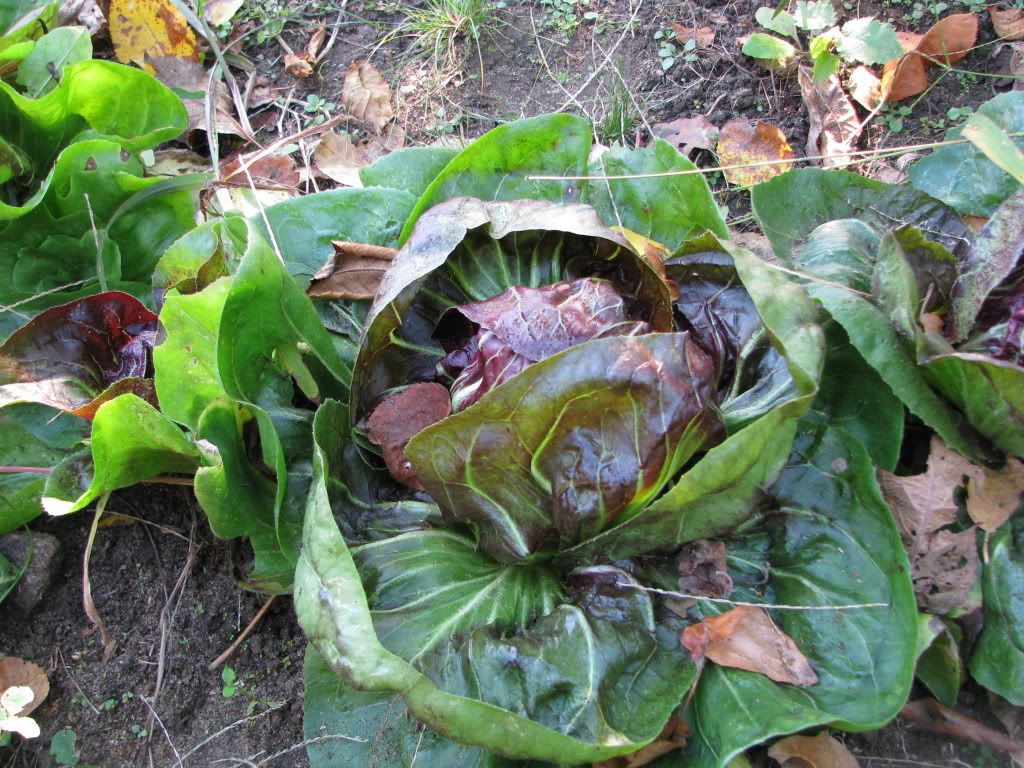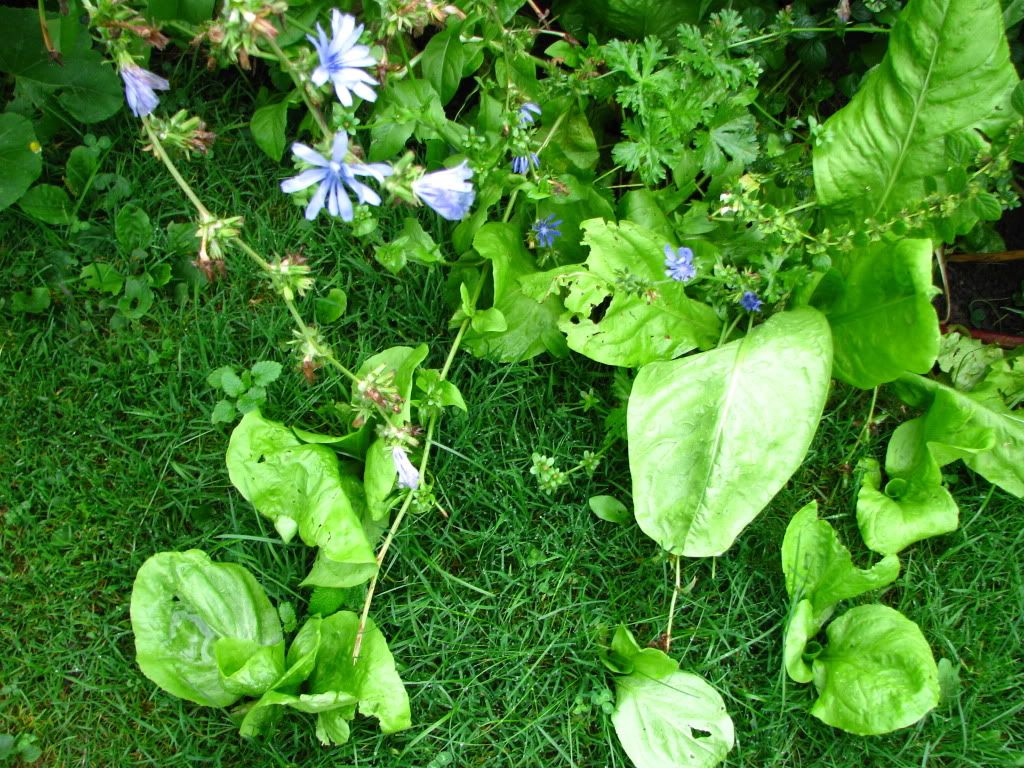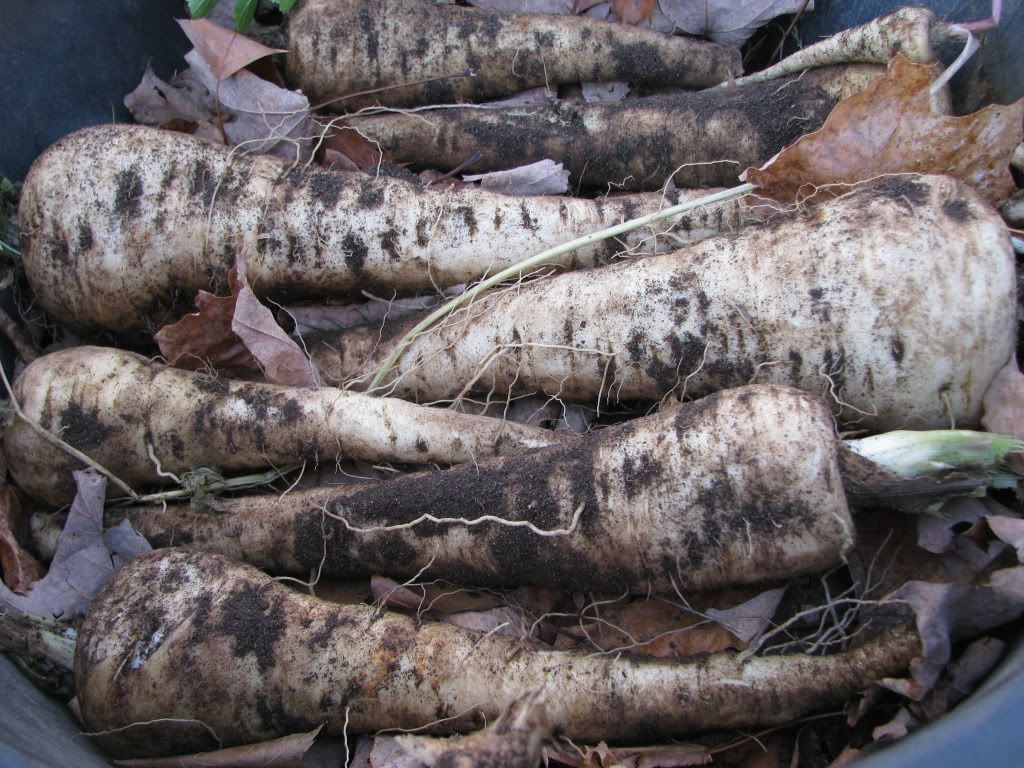 I had a nice harvest of parsnip that were grown in combination with Swiss Chard. Half the row was left in the ground to use in the spring and for seed.*The details of roots dug:
I had a nice harvest of parsnip that were grown in combination with Swiss Chard. Half the row was left in the ground to use in the spring and for seed.*The details of roots dug:I've been digging up roots while the ground is unfrozen to store in our cellar - not quite of the root kind as it's located in our basement so though it is insulated and cooler than the rest of the house, it's not particularly humid but I have stored in such conditions before with a fair amount of luck.
Roots represented for our winter harvest hopes include: carrot, beets, parsnips, winter 'daikon' radish, horseradish and jeruselum artichoke. Also packed away are dandelion roots, chicory, and celariac for forcing. Potted up for greens are swiss chard, bulb fennel and cardoon. I've also got some canna and dahlia bulbs (both technically edible - I've not tried them yet) and some gladiolas resting the cold away.
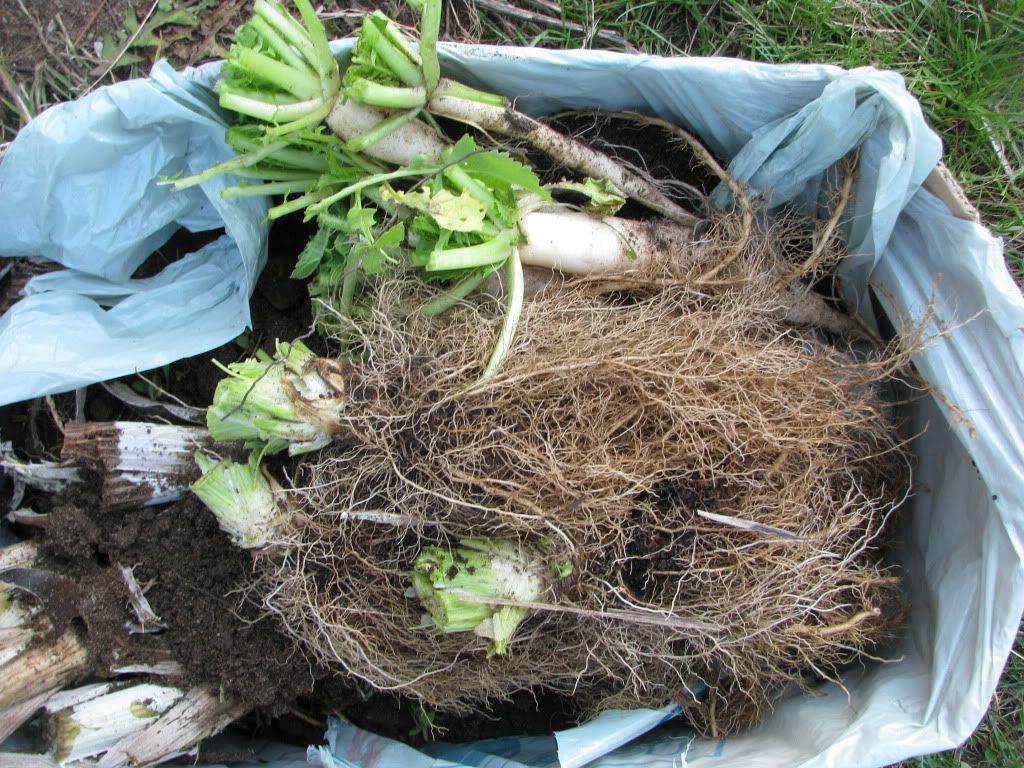 At the far left are trimmed cardoon leaves with some small, self seeded daikon radishes and some equally undersized celariac for storage. I plan on forcing the celariac for celery leaves. Not sure why it didn't want to grow this year but I'm guessing water stress as it was in the sandtrap garden. Next year, I'll incorporate more organic matter in its planting location. Celariac makes a decorative border.
At the far left are trimmed cardoon leaves with some small, self seeded daikon radishes and some equally undersized celariac for storage. I plan on forcing the celariac for celery leaves. Not sure why it didn't want to grow this year but I'm guessing water stress as it was in the sandtrap garden. Next year, I'll incorporate more organic matter in its planting location. Celariac makes a decorative border.Some of these are experimental. My attempts to find further references to overwintering globe artichoke roots - and therefore cardoon - have come to not.** The bulb fennel is another trial as its root is not dissimilar to carrot.
Next year, I'll have sweet cicely, divisions of lovage hopefully and oyster root (
Scorzonera and salsify) but for now, I want to increase my stock more than I want to eat them during the whiteout. Also resting undisturbed in the garden are crosnes (
Stachys affinis), and various multiplier onions.
Exciting discovery!So I've discovered that parsnips and Swiss Chard grow quite well together. I wasn't sure if the heavy leaf cover of the Swiss Chard would overcompete with the parsnips but perhaps, the different levels of the root growth - though Swiss Chard does have a tap like root, more obvious in some, it is not as long as the parsnip and has a lot bushy secondary roots near the surface - seem to have enabled them to be good neighbours. The first parsnip I pulled out from the clump of Swiss Chard was baseball bat sized. The only roots that weren't worth pulling were crowded out by their own kind. Clearly I didn't thin adequately when they germinated, probably thinking that the bugs would do it for me as they often do. It's a nice combination as the colourful Swiss Chard fills in the spaces between the parsnip leaves. If you want to go all out, planting this with a border of nasturtiums sets off the bright colours of varities like Rainbow Lights Chard or a mix of gold and reds. I also like to interplant Rhubarb with dark leafed swiss chard and maybe a border of dwarf red tipped marigolds or red English Daisy to play off the ruby theme.
Storing in autumn leaves: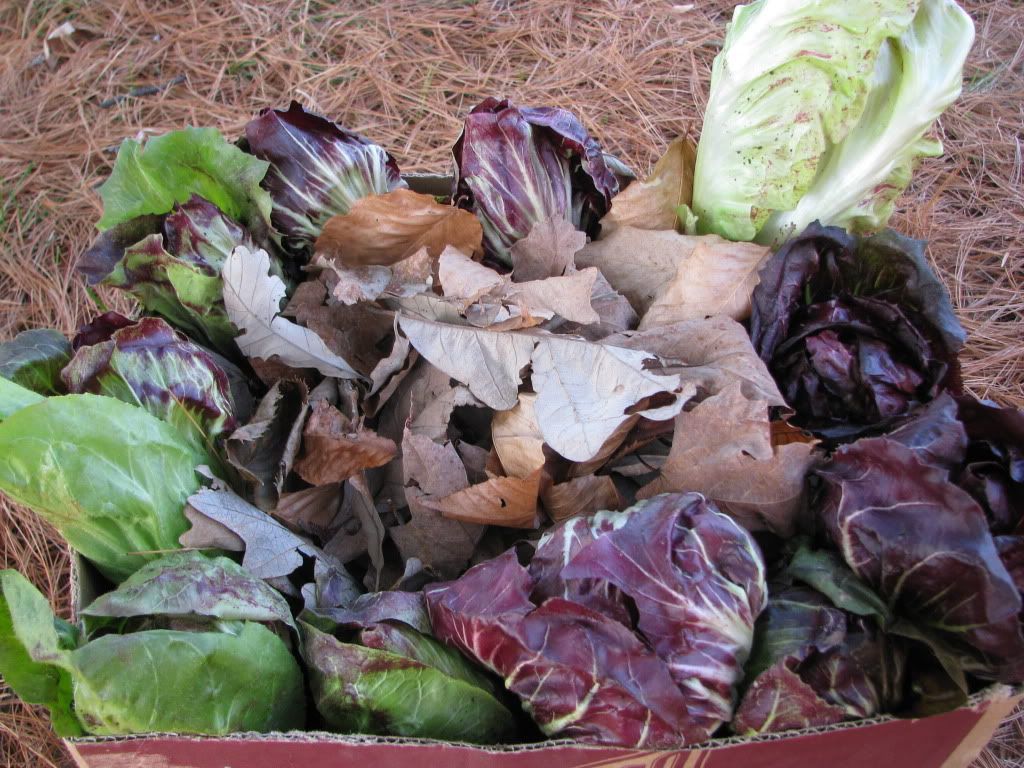 A range of chicory heads as pretty as flowers. I am going to cut and eat these over the next little while and then store the roots for forcing later if they so oblige. There are varieties specifically bred for forcing to produce Belgium Endive.
A range of chicory heads as pretty as flowers. I am going to cut and eat these over the next little while and then store the roots for forcing later if they so oblige. There are varieties specifically bred for forcing to produce Belgium Endive.Previously, I've always stored my roots in the quintessential moist sand (rarely) or in plain, old garden dirt (mostly) in low boxes. This year, I thought I'd try leaves as I've heard the odd mention of it. Apparently, a drawback is that the leaves will rot. In my case, that might help (assuming it doesn't affect the roots negatively) as it would add moisture. We'll see. To further increase humidity, I'll be adding bowls of water around the closed off basement cellar. Some of my roots are planted up in soil as well such as celariac, and others are loose. I'll report back how they do.
In the meantime - the how to: Typically roots that are stored for eating in the winter are those that can either go into dormancy before growing again like potatoes or are biennial so they wait until after a period of environmental change, such as cold, before resuming growth then flowering and setting seed. Therefore, storage either in the ground or in a special made storage place like a cellar is the way to get seeds from vegetables such as carrots and parsnips.
You can also extend the time that you get to eat some tasty greens like
celery by potting them up and bringing them inside. Which brings me to another fun thing to do with stored roots, force them. This means you take them from their cozy cellar bed of sand/dirt and pot them in some more sand/dirt and then place in a warm spot and water them. They will start to grow. If you want them to green up, then you'd place them in a sunny spot but if you want them to grow pale, delicate and sometimes more palatable, such as for dandelion yellows (sounds like a disease doesn't it but it tastes quite yummy) then grow them in the dark. This is the way that people produce
Belgium Endive or Chicons.*** Many leaves of roots are edible including turnip, beet, carrot (so I understand), chicory, radish, parsley root (and parsley), celariac and even cabbage.
 Some big ol' beets giving two harvests: leaves and roots. As siblings of Swiss Chard, you can use beet leaves in a similar way though they might be a bit tougher. The other day I fried them up with some garlic and mixed them together with coucous, an egg, a bit of wine vinegar and some flour then fried this as patties. It was sublime.
Some big ol' beets giving two harvests: leaves and roots. As siblings of Swiss Chard, you can use beet leaves in a similar way though they might be a bit tougher. The other day I fried them up with some garlic and mixed them together with coucous, an egg, a bit of wine vinegar and some flour then fried this as patties. It was sublime.A root cellar is the classic place to store roots that require cool temperatures and high humidity, though placing them in a plastic bag in your fridge works well too. If you live in mild climate, you could probably just dig them out of the ground on mild days or build a
clamp. Piling a bunch of fall leaves like a frost blanket over your in-ground roots will help keep frost out. I recently saw a suggestion in
motherearthnews to place these fall leaves in a plastic bag for easy removal and replacement. Good idea! Even for those in harsher climates, this would extend the time you had access to your in-ground roots. It is also a way to protect roots that might need a bit of help to make it through the winter.
I have a lot of success overwintering vegetables in situ for seed saving the next year or eating early in the spring. The only classic root crop that pops to my mind that never overwinters, except the obviously frost tender ones, are turnips. I also get heavy losses of carrots. We get heavy, consistent snow cover so this insulates the ground most years. However, I have no access to them for the same reason.
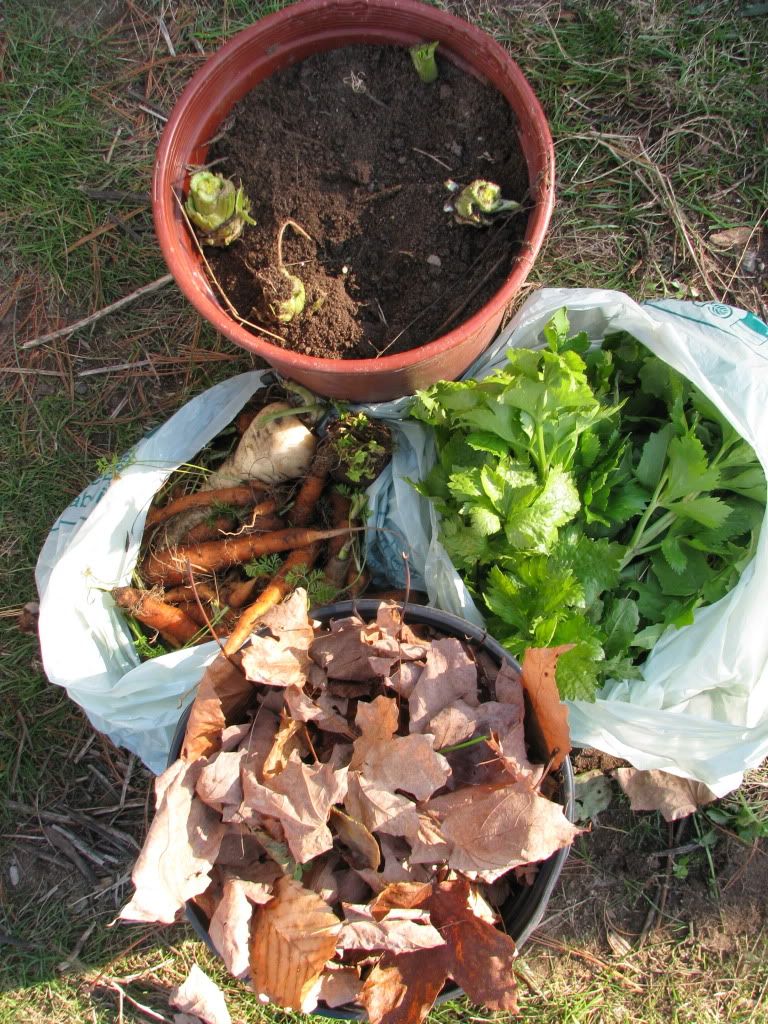 Some stuff I did earlier: potted celaric, some misc. roots stored in leaves, a bag of edible leaves that were cut off the roots to make a vegetable stock, and a bag of carrots for the fridge.
Some stuff I did earlier: potted celaric, some misc. roots stored in leaves, a bag of edible leaves that were cut off the roots to make a vegetable stock, and a bag of carrots for the fridge.To store:
1. Dig up roots as late as possible in the season. Be delicate with them
2. You don't need to remove all the dirt but feel free to brush off excess
3. Undamaged, well grown roots of storage varities do best
4. Trim off the greens to ~2 inch stubs - careful not to damage growing crown
5. Place in your favourite storage medium and container - generally recommended is sand, sawdust or vermiculite as medium in some sort of tub.
There are lots of good books and sites out there with charts to guide you when it comes to ideal storage conditions.
Here's a reference from good Cornell University.
* To select for the best plants, you can dig up your biennial roots, inspect for insect damage and qualities (even sampling a bit of the end of the root) then replant. It also doesn't hurt to give the roots a blanket of mulch to protect against frost unless you have a serious problem with rodents nibbling away at your roots.
** Actually I did find a couple mentions of people trying it but not picture filled examples of them succeeding so if you did this, speak up! I'm mostly interested in trying to force them for no reason other than curiousity. I have left some in the ground that I plan on covering with a thick layer of leaves and dirt (rather like a clamp) to see if I can carry them through in ground. Probably wishful thinking.
*** You won't be surprised to find out that there is more than one way to grow a chicon. You can also pot the roots up in sand/sandy soil, place in a cool spot and then when you want to force them, bring them into a warm, but dark place and water them. I've also read in Salad Leaves for All Sesons by Dowding that you can force them in a plastic bag (or as he put it a bin liner or polythene sack) in a warm, dark place. They can be laid horizontally.
